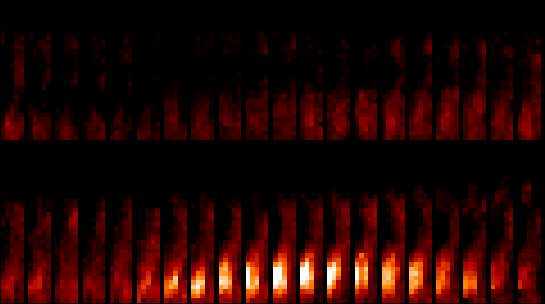The term "blinker" was recently coined to describe numerous explosions seen on or just above the surface of the sun. As far as I know, there is no classical explanation for these objects.
Blinkers have been found to coincide with electromagnetic bursts of radiation from the radio end of the spectrum to the x-ray end of the spectrum. (If you know of an animation of this phenomena, please E-mail me.)
Here is an animated GIF of a blinker exploding on the surface of the sun. (It should repeat 3 times, if you would like to see it play again, just Reload the graphic.)
This animated gif was created by myself using a graphic from the SOHO satellite. The original graphic looked like this,

The size of these Blinkers is enormous. They have been estimated to range in size between roughly the area of the United States and the size of earth. (Let me be clear, a Blinker is an explosion created by a ball-of-light. The explosion is roughly the size of earth, not the ball-of-light that created it. The original ball-of-light that exploded was much smaller.)
"The flashes, each of them about the size of the Earth, erupt across all parts of the sun's surface like a kind of disease, say scientists from the Royal Astronomical Society.
It's like water bubbling in a pan," said Peter Bond, space science adviser at the Royal Astronomical Society. A team of astronomers, led by Richard Harrison of the Rutherford Appleton Laboratory in Oxfordshire, southern England, first noticed the flashes, which scientists call "blinkers," last year.
They were picked up by a spectrometer on the European Space Agency's Solar and Heliospheric Observatory, launched in December 1995, which orbits the sun at a position between it and the Earth.
Although the blinkers "appear to be rather insignificant, since they are small and emit only one millionth the energy of a solar flare, they are distributed over the entire sun and are visible for several minutes" throughout the day, the Royal Astronomical Society said."From their Press Release -- January 27, 1998
Another image of one looks like this,
I am not sure, but there may be a second blinker in these images in the upper left, and possibly a small one below and to the left of the 2 in the middle image.
Again, the Ball-of-Light Particle Model predicts these objects are decaying balls-of-light. They are single objects exploding. They are smaller in size than the kind of ball-of-light that would make a sunspot because they give off "only one millionth the energy of a solar flare" and because exploding sunspots produce the solar flares.
Still, these things are almost unbelievable. If there were only a few of them spotted on the sun every month or so, they would surely be a very interesting curiosity. However, it is estimated that there are roughly 3,000 of these explosions visible on the sun at any one time!
Little Bursts or Big Bangs?
Another discovery from CDS is the fact that within the bubbling structure in the lower solar atmosphere one sees little bursts. Like some kind of solar disease, there are perhaps 3000 of these over the Sun at any point in time. They are little by solar standards, but as far as the Earth is concerned they are huge. The biggest may be the size of the Earth and over just a few minutes they burn at the power of 200 billion light bulbs!From SOHO web site
(offsite link http://sohowww.nascom.nasa.gov/)
Click on Gallery and CDS or LASCOX-Ray Image of Sun -- Showing decaying balls-of-light
Some balls-of-light that created by the sun's core do not explode on the sun's surface. They explode in the sun's atmosphere. Another image from the SOHO satellite shows x-ray emission from decaying balls-of-light in the outer atmosphere of the sun -- called the corona.
In this x-ray image, you can literally see the decaying balls-of-light. Each of the tiny spots in this image are local sources of x-rays.
Explaining the High Temperature of the CoronaOne of the mysteries of the sun has been the extreme temperature of the sun's corona -- about 1 million degrees C -- compared to the much cooler temperature of the sun's surface -- about 5,500 degrees C. In other words, there must be some mechanism that heats the corona -- in the corona -- because temperatures rise as distances from the sun's surface increase. (The traditional law of gases predicts that the temperature should decrease not increase.)
The Ball-of-Light Particle Model predicts the extreme temperature in the corona is caused by decaying balls-of-light, made by the core of the sun, that have bubbled up through the sun's envelope, escaped into the atmosphere of the sun, and exploded in the corona. The x-ray image of the sun above graphically shows these balls-of-light decaying. These decays produce the high energy x-rays.
It takes a lot of energy to create x-rays. Ask yourself how, using traditional astrophysics, so many explosions of x-rays could be produced in the corona of the sun?! Maybe, using traditional astrophysics, you could say gravity is condensing localized clumps of hydrogen that become so hot they suddenly burst in thermonuclear explosion! Or, maybe there are little black holes hovering all over the surface of the sun and hydrogen spirals into them suddenly releasing the x-ray emission! I am not trying to make fun of anyone, but explanations like these are absurd. Similar arguments are being used all of the time to explain all sorts of astrophysical phenomenon.
A close-up of this image's upper left corner allows you to see the individual decaying balls-of-light that are emitting the x-ray light.
(See also balls-of-light that are emitting x-rays in supernova's.)